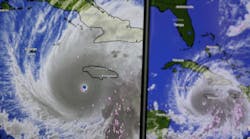Los Angeles River Pollution Lands Boeing Fines
Allowing storm water runoff and wastewater discharges with elevated levels of chromium, dioxin, lead, mercury and other pollutants to enter a tributary of the Los Angeles River has cost the Boeing Co. $471,190 in fines issued by the Los Angeles Regional Water Quality Control Board (LARWQCB).
The penalties were for 79 violations of Boeing's permit, which occurred between October 2004 and January 2006 at Boeing's Santa Susana Field Laboratory in Simi Valley. The pollutants entered Bell Creek, a tributary to the Los Angeles River, and the Arroyo Simi.
"I am extremely concerned and alarmed whenever pollution reaches our rivers, lakes or beaches," said Francine Diamond, chairwoman for the LARWQCB. "Water pollution harms our drinking wawter aquifers and threatens human health, aquatic life and our multibillion dollar coastal economy. It is absolutely critical that water quality laws are rigorously followed and violations are seriously addressed."
Upon the issuing of the complaint, the public was notified of the opportunity to comment on the proposed fine, and Boeing had 30 days to decide whether to contest the allegations in the complaint and the imposition of administrative civil liabilities by the Regional Board. On Aug. 27, Boeing elected not to challenge the allegations in the complaint and the amount of civil liability, and the company submitted full payment.
"It is not uncommon for fines to be questioned by those who say they are too high as well as those who say they are too low," said Interim Executive Officer Deborah Smith. "Staff takes their enforcement role seriously and exercises great care in making sure that their recommendations are sound, responsible and defensible. This near half-million dollar penalty is a clear statement that violations of California's clean water laws will not be tolerated and will result in significant penalties."
The California Water Code specifies how money collected for water quality violations can be allocated. In most cases, a portion of any fine for violating permit limits must be deposited in the Cleanup and Abatement Account, which is used for environmental cleanups throughout California. The remaining portion can be used to fund environmental programs that benefit the geographic area impacted by the violation. The LARWQCB has a preapproved list of environmental projects for this purpose.
Boeing's fine will be split into four allocations. The largest amount, $235,595, will be deposited in the Cleanup and Abatement Account, managed by the State Water Resources Control Board. A sum of $199,500 will fund a study on how trace metals such as copper are transported from watersheds to estuaries and to determine their impact on water quality and habitat and aquatic life. This study will be conducted by the Southern California Coastal Water Research Project. The Santa Monica Baykeeper will receive $22,000 of the fine for kelp bed restoration in the Santa Monica Bay. Finally, $14,095 will fund the creation and distribution of a publication identifying environmentally beneficial ways to manage storm water runoff. This project will be overseen by the Los Angeles and San Gabriel Rivers Watershed Council.
"There is some comfort in knowing that the money collected for violating clean water regulations is used to restore and protect the environment," Diamond said. "I am pleased that the Regional Board has the authority to allocate a significant portion of Boeing's penalty--over $235,000--to three projects that will greatly benefit our local watersheds."
Source: Environment News Service

